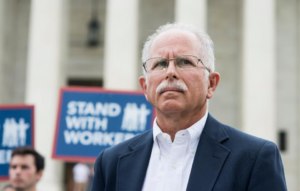Teachers Unions Face a Deserved Reckoning from the Supreme Court
 UNITED STATES – JUNE 27: Illinois state employee Mark Janus stands outside of the U.S. Supreme Court after the decision in the Janus v. AFSCME case was handed down in his favor on Wednesday, June 27, 2018. Janus argued the fees public-sector unions collect from nonmembers to cover the cost of actions that help all employees are coerced speech that violated his First Amendment rights. (Photo By Bill Clark/CQ Roll Call)
UNITED STATES – JUNE 27: Illinois state employee Mark Janus stands outside of the U.S. Supreme Court after the decision in the Janus v. AFSCME case was handed down in his favor on Wednesday, June 27, 2018. Janus argued the fees public-sector unions collect from nonmembers to cover the cost of actions that help all employees are coerced speech that violated his First Amendment rights. (Photo By Bill Clark/CQ Roll Call)
By Matt Patterson
What are we getting for our education dollars? Not much, as it turns out.
In fact, while the U.S. outspends most developed nations on education, it consistently lags in student achievement, ranking 24th in science, 38th in math and 24th in reading, according to the Pew Research Center.
How do we explain this distressing phenomenon? Why do our children struggle in school in spite of the vast amounts of money we pour into these institutions?
The answer may be found by looking at the schools which are excelling. Success Academy in New York City, for example, where95 percent of (mostly low-income) students pass math. On the other coast, High Tech Los Angeles graduates 92 percent of its (mostly low-income minority) students, and is ranked among America’s best high schools by U.S. News.
What do schools like these have in common? They are largely free of the poison that is unionization.
Teachers at unionized schools are almost impossible to fire thanks to collective bargaining agreements that forbid performance-based pay and tenure. The result: millions of children languish in classrooms run by teachers with no incentive to perform or to ensure that students perform.
So the children suffer while the union leadership gets rich. (The President of the American Federation of Teachers makes over $400,000 a year in total compensation).
But not in charter schools, which are mostly non-union and are therefore given much more leeway in hiring and firing, merit-pay, tenure, etc. That is the reason they consistently outperform their unionized counterparts in graduation rates, test scores, and nearly every other metric.
But the U.S. Supreme Court has just delivered a decision that may help break the back of the teachers’ unions. In Janus v. AFSCME, the Court ruled that no public employee, including teachers, can be compelled to financially support a union. According to Justice Alito, writing for the majority:
“The First Amendment is violated when money is taken from non-consenting employees for a public-sector union; employees must choose to support the union before anything is taken from them. Accordingly, neither an agency fee nor any other form of payment to a public-sector union may be deducted from an employee, nor may any other attempt be made to collect such a payment, unless the employee affirmatively consents to pay.”
What does this mean for teachers? It means they can keep their money, money that unions have been spending on left-wing politics for decades.
What does this mean for school districts? It means that the union will have a lot less power to bully themselves budget-busting bargaining agreements.
Most importantly, what does this mean for students? It may, just may, mean that the public schools which have failed them for so long may, at last, be allowed to try and improve.
There’s been a lot of ink spilled about the winners and losers in the Janus case and what it means for the political makeup of the country. But somewhere there’s a child stuck in a terrible school who doesn’t even know about this decision but who nonetheless may be the biggest winner of all.
Renee Olivett contributed research to this report.
Matt Patterson is field director for the California Policy Center and president of 1st Amendment First. He can be reached at Matt@calpolicycenter.org. Originally posted on Forbes.
